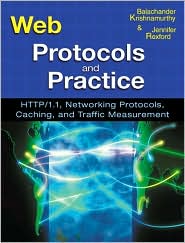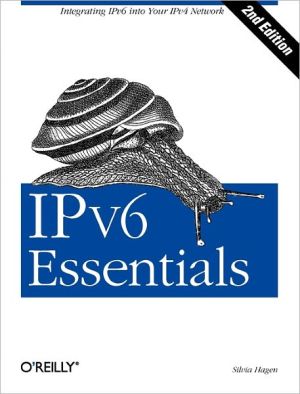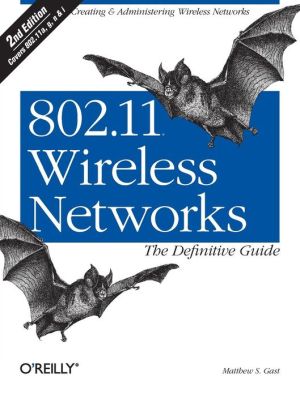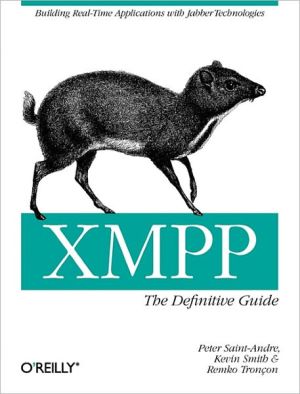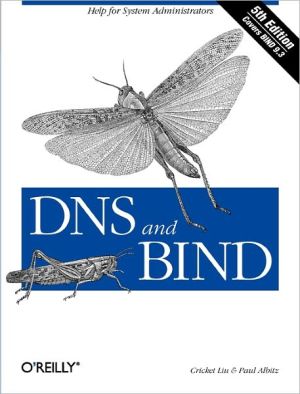Web Protocols and Practice: HTTP/1.1, Networking Protocols, Caching, and Traffic Measurement
Praise for Web Protocols and Practice\ “This is the most comprehensive, well-researched coverage of the basic Web protocols that I have seen. The authors have done especially well at uncovering the history and rationale of the protocol design process.”\ —Jeffrey Mogul, coauthor of the HTTP/1.1 standard\ “This book will help demystify how the Internet and the Web work. Despite the current Web’s size and importance, it can be broken down...
Search in google:
A reference to the core technologies underlying the World Wide Web, with an extensive treatment of HTTP/1.1 and its interaction with other protocols. Features numerous examples and case studies throughout, as well as comprehensive documentation of the technical backbone of the Internet. Booknews This guide for professionals and students of Web technology describes the technical underpinnings of the World Wide Web. Krishnamurthy and Rexford (both AT&T Labs-Research) discuss the systems and protocols responsible for the transfer of Web content. The focus is on the mature and stable aspects of the Web, rather than the rapidly changing techniques for creating and displaying Web content. The volume includes detailed examples of the HTTP protocol, an overview of Web caching and multimedia streaming, and case studies of the Apache Web server, the Squid proxy, and traffic measurement techniques. Annotation c. Book News, Inc., Portland, OR (booknews.com)
Introduction\ This book describes the technical underpinnings of the World Wide Web. We discuss the technology for transferring, caching, and measuring the messages that carry the content between Web sites and end users. The messages are exchanged between clients, proxies, and serversthe three main software components of the Web. The format and transfer of these messages are dictated by communication protocols codified in standards documents over a period of years. Evaluating and improving Web performance relies on having effective techniques for collecting and analyzing measurements of the message traffic. By moving Web content closer to the end users, caching reduces user-perceived latency, as well as load on the Web servers and the underlying network. Web traffic is moving from delivery of text and image content to include audio and video streaming. Multimedia streaming has its own suite of communication protocols. These topics, constituting the technical core of the Web, are discussed in detail in this book.\ This book provides a comprehensive treatment of the systems and protocols responsible for the transfer of Web content. The audience for this book includes Web technologists, Web site administrators, developers who rely on the Web infrastructure, students in networking and the Web, and the Web research community. The book focuses on the mature and stable aspects of the Web. In contrast to the rapidly changing techniques for creating and displaying Web content, the standardized communication protocols discussed in the book change relatively slowly. A variety of examples, state-of-the-art reports, and case studies are used to illustrate the operation of the Web and the interplay among the various components. The book includes detailed examples of the HTTP protocol, a state-of-the-art overview of Web caching and multimedia streaming, and case studies of the Apache Web server, the Squid proxy, and traffic measurement techniques. The book is a valuable resource for understanding the technology and current practices of the Web.\ Organization of the Book\ The first section of the book consists of an opening chapter that provides a broad overview of the evolution of the World Wide Web and discusses the Web's naming infrastructure, document language, and message exchange protocol. The remainder of the book is divided into five sections consisting of 14 chapters:\ \ Software components: These three chapters present the inner workings of clients, proxies, and servers, including a discussion of related topics such as scripts, handlers, search engines, cookies, and authentication.\ Web protocols: The core of the book, these four chapters present the networking protocols underlying the Web (Internet Protocol, Transmission Control Protocol, and the Domain Name System), the design of HTTP/1.0, a comprehensive overview of HTTP/1.1, and the interaction between http and TCP.\ Traffic measurement and workload characterization: These two chapters describe the various techniques for measuring and analyzing Web traffic, as well as an overview of the key parameters of Web workload models used in evaluating Web performance.\ Web caching and multimedia streaming: These two chapters provide a state-of-the-art overview of key Web applications. Web caching involves moving content closer to the user to reduce user-perceived latency and the load on the server and the network. Multimedia streaming involves overlapping the transfer of audio and video data with the playback at the receiver.\ Research perspectives: These three chapters present research perspectives on caching, measurement, and protocols to provide a glimpse of the evolving technology in these areas and reinforce the material presented in the earlier parts of the book.\ \ Intended Audience\ The book is self-contained and does not assume any prior knowledge of Web or networking technology. An extensive bibliography points readers to additional information on specific topics. The book has several audience segments, including:\ \ Students: Undergraduate students in advanced courses and graduate students can use the book as an introduction to the protocol, network, and measurement aspects of the Web. The book is self-contained and does not assume the student is familiar with network protocols. We do assume a basic familiarity with computer science concepts. The book includes case studies and research perspectives to guide students in applying the ideas they have learned. The book's focus on core concepts and protocol evolution ensures that the student acquires knowledge that has broad applications beyond any particular realization of Web technology.\ Web technologists: The book provides developers with an in-depth treatment of the various protocols and software components in the Web. A developer can learn about HTTP and the related networking protocols, such as IP, TCP, and DNS, and their relationship to Web clients, proxies, and servers. In addition, the book includes an extensive treatment of Web traffic measurement andworkload characterization that can aid developers in evaluating and improving the performance of their software in realistic settings.\ Web and networking researchers: Academic and industrial researchers can use the book as a primary source of information about the technical underpinnings of the Web and its relationship to the Internet. The core portions of the book highlight the mature technologies underlying the Web, to provide the necessary context for research work in this area. The advanced material on research perspectives provides a timely view of ongoing work that may influence the evolution of the Web, and the extensive bibliography points the reader to research publications and standards documents with additional details.\ Web administrators: Administrators of Web proxies and servers can develop a deeper understanding of the operation of these software components. The book can serve as a reference for key concepts and protocol features. The emphasis on performance issues can aid administrators in tuning the configuration of a proxy or server, complementing other texts that present detailed guidelines of how to configure a particular hardware or software platform. The material on Web measurement and the interaction between HTTP and networking protocols can help administrators in diagnosing performance problems.\ \ The book can be used as a reference, a self-study guide, or part of a one- or two-semester course on Web technology or networking. Readers may follow a variety of paths through the book, depending on their backgrounds and interests. Some readers may skip the elementary chapters, whereas other readers may skip the research perspectives material.
PrefaceAcknowledgmentsIGetting Started11Introduction3IIWeb Software Components212Web Clients233Web Proxies594Web Servers81IIIWeb Protocols1175Protocols Underlying HTTP1196HTTP Protocol Design and Description1737HTTP / 1.12178HTTP/TCP Interaction301IVMeasuring/Characterizing Web Traffic3379Web Traffic Measurement33910Web Workload Characterisation369VWeb Applications40511Web Caching40712Delivering Multimedia Streams443VIResearch Perspectives47713Research Perspectives in Caching47914Research Perspectives in Measurement50915Research Perspectives in Protocol Issues535Bibliography583Index609
\ BooknewsThis guide for professionals and students of Web technology describes the technical underpinnings of the World Wide Web. Krishnamurthy and Rexford (both AT&T Labs-Research) discuss the systems and protocols responsible for the transfer of Web content. The focus is on the mature and stable aspects of the Web, rather than the rapidly changing techniques for creating and displaying Web content. The volume includes detailed examples of the HTTP protocol, an overview of Web caching and multimedia streaming, and case studies of the Apache Web server, the Squid proxy, and traffic measurement techniques. Annotation c. Book News, Inc., Portland, OR (booknews.com)\ \
